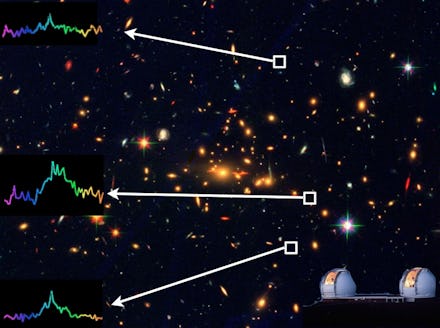Astronomers Just Looked Back in Time 13 Billion Years — "Where No Human Has Seen Before"

Astronomers just captured an image of the faintest galaxy we've ever glimpsed, and it could help us unravel the mystery of how the universe got started and what made the first stars visible.
A new instrument on the Keck telescopes in Hawaii, used a phenomenon called "gravitational lensing," to give us a glimpse of the galaxy. It's only about 1% of 1% of the mass of our own Milky Way, according to Keck astronomer Marc Kassis.
Gravitational lensing happens when the gravity of a closer objects magnifies the light from a more distant object. Sometimes, the phenomenon reflects multiple images of the same thing — which is why you can see three images of the galaxy below:
The result is a picture of what this galaxy looked like 13 billion years ago: It's essentially a baby picture of the universe, and we're seeing "where no human has seen before," according to astronomer Marusa Bradac.
The result is a picture of what this galaxy looked like 13 billion years ago. It's essentially a baby picture of the universe.
Thirteen billion years ago is a significant moment in the universe's past. That's when all the gas between galaxies got ionized and the first stars became visible. Studying faint galaxies may help us figure out why that happened.
"It's a very, very small galaxy, and at such a great distance, it's a clue in answering one of the fundamental questions astronomy is trying to understand: What is causing the hydrogen gas at the very beginning of the universe to go from neutral to ionized about 13 billion years ago," according to Kassis. "That's when stars turned on and matter became more complex."